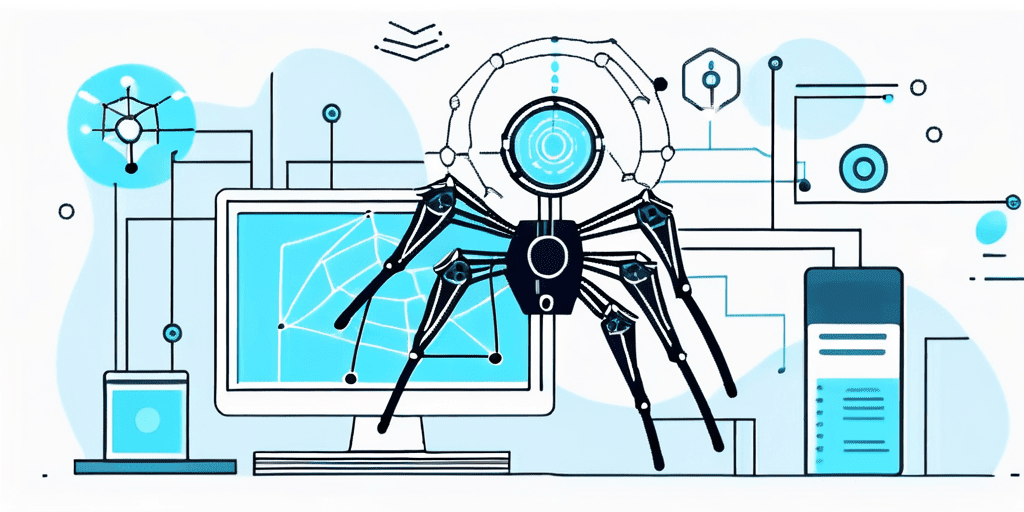In today’s digital age, where vast amounts of data are readily available online, web scraping has become an essential skill for many professionals. Whether you are a data analyst, a market researcher, or an entrepreneur looking for valuable insights, understanding the ins and outs of web scraping is crucial. This article aims to provide a comprehensive guide to the essentials of web scraping, covering its definition, legal aspects, tools and technologies, the process involved, and troubleshooting common issues.
Understanding Web Scraping
Definition and Purpose of Web Scraping
At its core, web scraping is the process of collecting data from websites automatically. It involves extracting information from web pages and saving it in a structured format, such as a spreadsheet or a database. Web scraping enables you to gather data from various sources quickly and efficiently, allowing for powerful analysis and decision-making.

The Role of Web Scraping in Data Gathering
With the proliferation of websites and the exponential growth of online content, manually collecting data from the web becomes an arduous and time-consuming task. Web scraping automates this process, enabling you to extract data from multiple websites simultaneously. This capability is particularly beneficial for businesses and organizations that rely on robust data collection for market research, competitor analysis, pricing strategies, and more.
Let’s delve deeper into the fascinating world of web scraping and explore some of its key applications. One such application is sentiment analysis, where web scraping can be used to extract customer reviews and feedback from various websites. By analyzing this data, businesses can gain valuable insights into customer opinions, preferences, and satisfaction levels, helping them make informed decisions to improve their products or services.
Another important application of web scraping is in the field of finance. Financial institutions can utilize web scraping to gather data on stock prices, market trends, and economic indicators from different financial websites. This data can then be used for predictive modeling, risk assessment, and investment strategies. By automating the data collection process, web scraping empowers financial professionals to make data-driven decisions in a timely manner.
The Legal Aspects of Web Scraping
Ethical Considerations in Web Scraping
While web scraping offers incredible opportunities, it is essential to approach it ethically and responsibly. As a web scraper, it is crucial to respect website owners’ terms of service, privacy policies, and intellectual property rights. Make sure to obtain the necessary permissions or consult legal experts when dealing with sensitive data or when scraping websites with strict access restrictions.
When engaging in web scraping activities, it is important to consider the ethical implications of your actions. While scraping can provide valuable data for research, analysis, and innovation, it is crucial to ensure that your scraping practices do not infringe upon the rights of others. This means being mindful of the impact your scraping may have on website performance, server load, and user experience. By implementing responsible scraping techniques, such as using appropriate scraping intervals and respecting robots.txt files, you can minimize any negative effects on the websites you scrape.
Legal Boundaries and Restrictions
Although web scraping is a valuable tool, it is essential to be aware of the legal boundaries and restrictions associated with it. Different countries have varying regulations regarding web scraping, and certain actions may be prohibited or restricted. For example, scraping personal data without consent or circumventing CAPTCHA or IP blocking measures can lead to legal consequences. It is crucial to familiarize yourself with the laws and regulations in your jurisdiction to ensure compliance.
Moreover, it is worth noting that even if web scraping is legal in your jurisdiction, there may still be limitations imposed by the website owners themselves. Many websites have implemented measures to protect their data and prevent scraping, such as implementing CAPTCHA challenges or IP blocking. It is important to respect these measures and refrain from engaging in any activities that may violate the website’s terms of service or disrupt its normal operation.
Furthermore, it is advisable to keep up-to-date with any legal developments or court rulings related to web scraping. The legal landscape surrounding web scraping can evolve over time, and staying informed about any changes can help you navigate the legal aspects more effectively. Consulting with legal experts or joining online communities dedicated to web scraping can provide valuable insights and guidance on the latest legal considerations.
Tools and Technologies for Web Scraping
Overview of Web Scraping Tools
When it comes to web scraping, several tools and technologies can simplify the process. These tools range from simple browser extensions to powerful programming libraries. Some popular options include BeautifulSoup, Scrapy, Selenium, and Puppeteer. Choosing the right tool depends on your specific requirements, such as the complexity of the websites you need to scrape, the extent of automation needed, and the programming language you are comfortable with.
Choosing the Right Technology for Your Needs
Before diving into web scraping, it is crucial to evaluate your needs and choose the technology that aligns best with your goals. Consider factors such as ease of use, scalability, and the ability to handle dynamic content. Some websites heavily rely on JavaScript to load data dynamically, requiring tools like Selenium or Puppeteer that can interact with the rendered HTML. Remember to stay up to date with the latest advancements in web scraping technologies to leverage their full potential.
Let’s take a closer look at some of these web scraping tools. BeautifulSoup, a Python library, provides a simple and intuitive way to parse HTML and XML documents. It allows you to navigate through the document structure, extract specific elements, and retrieve the desired data effortlessly. With its extensive documentation and active community support, BeautifulSoup is an excellent choice for beginners.
On the other hand, if you are looking for a more robust and scalable solution, Scrapy might be the right tool for you. Built on top of Python, Scrapy provides a powerful framework for web scraping, allowing you to build and manage complex scraping projects with ease. It offers features like automatic request throttling, built-in support for handling cookies and sessions, and the ability to export scraped data in various formats.
When it comes to scraping websites that heavily rely on JavaScript, tools like Selenium and Puppeteer come to the rescue. Selenium is a widely used automation tool that enables you to control web browsers programmatically. It allows you to interact with web elements, simulate user actions, and scrape data from dynamically loaded content. Puppeteer, on the other hand, is a Node.js library that provides a high-level API for controlling headless Chrome or Chromium browsers. It offers powerful features like taking screenshots, generating PDFs, and even running automated tests.
As you can see, there is a wide range of tools and technologies available for web scraping, each with its own strengths and use cases. It’s essential to carefully evaluate your needs and choose the right tool that suits your specific requirements. By selecting the appropriate technology and staying updated with the latest advancements, you can streamline your web scraping process and extract valuable data efficiently.
The Process of Web Scraping
Planning Your Web Scraping Project
Like any project, proper planning is essential for successful web scraping. Before diving into code or utilizing scraping tools, clearly define your objectives and the specific data you need to extract. Identify the target websites, analyze their structure, and understand the required workflow. Additionally, anticipate potential challenges such as handling login credentials, working with pagination, or addressing CAPTCHA requirements.

When planning your web scraping project, it is crucial to consider the legal and ethical aspects as well. Ensure that you are familiar with the website’s terms of service and any applicable laws regarding data scraping. Some websites may have specific restrictions or may even prohibit scraping altogether. It is important to respect these guidelines and obtain proper permissions if necessary. By adhering to ethical practices, you can avoid potential legal issues and maintain a positive reputation in the web scraping community.
Executing a Web Scraping Task
Once you have planned your web scraping project, it’s time to execute the task. This involves writing or configuring the scraping code, setting up the necessary programming environment, and running the scraping process. Throughout the process, closely monitor the data quality, handle errors gracefully, and ensure proper data storage. Regularly validate the scraped data to maintain accuracy and adjust your code or parsing logic as needed.
During the execution phase, it is important to be mindful of the website’s server load and response time. Sending too many requests in a short period of time can put strain on the server and may even result in your IP address being blocked. To mitigate this risk, you can implement techniques such as rate limiting or using rotating proxies to distribute the requests across different IP addresses. By being considerate of the website’s resources, you can ensure a smoother scraping process and minimize the chances of being blocked.
Furthermore, it is worth mentioning that web scraping is an iterative process. As you gain more experience and extract data from different websites, you will encounter various challenges and learn new techniques. It is important to continuously improve your scraping code and stay up-to-date with the latest developments in the field. By constantly refining your skills, you can enhance the efficiency and effectiveness of your web scraping projects.
Troubleshooting Common Web Scraping Issues
Dealing with Dynamic Content
One of the primary challenges in web scraping is dealing with websites that dynamically load data through JavaScript. To scrape such websites, consider using headless browsers like Selenium or Puppeteer. These tools can interact with the rendered HTML and JavaScript to obtain dynamic content. Employ techniques like waiting for elements to load, analyzing network requests, or utilizing APIs if available to extract the desired data.

Overcoming CAPTCHA and IP Blocking
Websites often implement measures like CAPTCHA and IP blocking to deter web scraping. Overcoming these challenges requires careful consideration and adherence to ethical practices. Some strategies to bypass CAPTCHA include utilizing OCR techniques, employing third-party solving services, or using machine learning models. To avoid IP blocking, consider rotating proxies or utilizing IP rotation services that assign new IP addresses dynamically.
However, it’s important to note that while these methods may help you overcome CAPTCHA and IP blocking, they should be used responsibly and within legal boundaries. It is crucial to respect website owners’ terms of service and privacy policies when scraping their data.
Furthermore, it’s essential to stay up-to-date with the latest developments in CAPTCHA and IP blocking techniques. Websites are constantly evolving their security measures to prevent scraping, and what may work today might not work tomorrow. Therefore, it’s crucial to continuously adapt your scraping strategies and explore new technologies and approaches.
In conclusion, web scraping offers immense possibilities for data gathering and analysis. Understanding the essentials of web scraping, including its definition, legal aspects, tools and technologies, the process involved, and troubleshooting common issues, empowers professionals to extract valuable insights from the ever-expanding wealth of online information. By approaching web scraping in an ethical and responsible manner, respecting legal boundaries, and leveraging the right tools and technologies, individuals and businesses can unlock a world of data-driven opportunities.
If you’re looking to safeguard your business’s online data and ensure compliance with industry standards, Blue Goat Cyber is here to help. As a Veteran-Owned business specializing in B2B cybersecurity services, we understand the importance of protecting your digital assets. From medical device cybersecurity to HIPAA and FDA compliance, SOC 2 and PCI penetration testing, our expertise is your frontline defense against cyber threats. Contact us today for cybersecurity help and partner with a team that’s passionate about securing your business and products from attackers.
